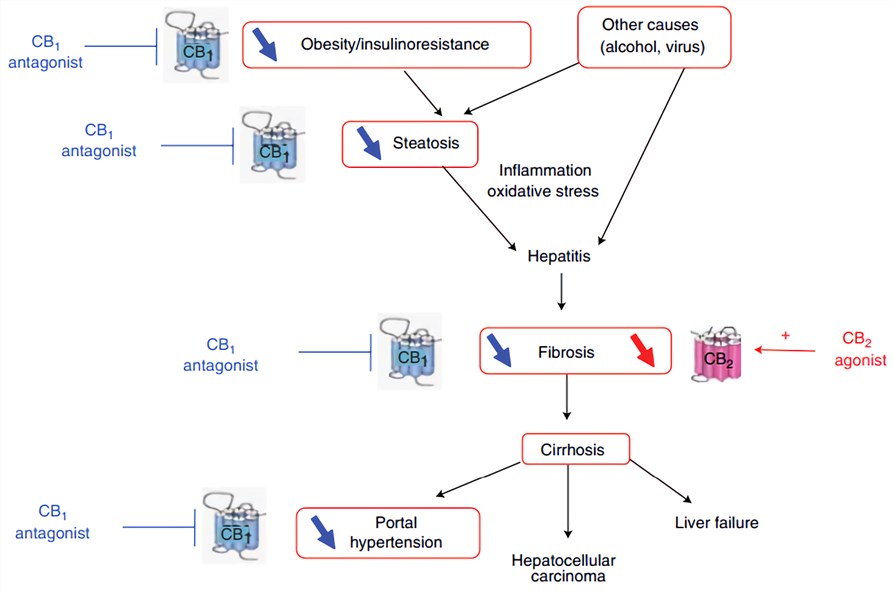NASH Target Development Service for Cannabinoid Receptors CB1, CB2
Cannabinoid receptors (CB1 and CB2) play a very important role in non-alcoholic steatohepatitis (NASH), especially their agonists, which have beneficial effects on metabolic regulation in animal models of NASH and are important targets for NASH therapy. With extensive experience and a high-end platform and state-of-the-art technology in drug discovery, Creative Biolabs offers the identification of multiple targets related to NASH and the synthesis of multiple drugs such as their antagonists or agonists.
Introduction of Cannabinoid Receptors CB1, CB2
The endocannabinoid system (ECs), consisting of cannabinoid receptors (CB1 and CB2 receptors), their endogenous ligands, such as anandamide and 2-arachidonylglycero, and their biosynthetic and degradative enzymes, have recently emerged as a ubiquitous system with key functions in a variety of physiological settings. EC is widely involved in central and peripheral lipid metabolism primarily through activation of CB1 and CB2 receptors. CB1 and CB2 play different roles in cell apoptosis and fibrogenesis in the liver, mediating different liver diseases. Their receptors have a 44% amino acid identity and belong to the G protein-coupled receptor family. CB1 receptors are expressed at high levels in the brain and at lower levels in most of the peripheral tissues. These receptors are exclusively responsible for the central psychotropic and behavioral effects of cannabinoids and are also involved in a wide variety of peripheral functions, such as the control of energy homeostasis, cardiovascular function, and reproduction, etc. In contrast, CB2 receptors are expressed predominantly in immune and have been detected in hematopoietic cells. They play a key role in regulating immune and inflammatory responses. CB1 and CB2 receptors mediate a variety of physiological processes of the nervous and immune systems and liver, they are considered to be putative therapeutic agents for the treatment of neurodegenerative diseases and inflammatory pain as well as certain liver diseases.
Cannabinoid Receptors CB1, CB2 for NASH Treatment
NASH is characterized by hepatic fat deposition, inflammation, and varying degrees of fibrosis. The CB receptors are increasingly emerging as the crucial mediators of acute and chronic liver injury. Peripheral activation of CB1 receptors promotes insulin resistance and liver steatogenesis, two key steps in the pathogenesis of NASH. Moreover, CB1 receptor activation leads to increased de novo fatty acid synthesis as well as decreased fatty acid oxidation and enhances the progression of liver fibrogenesis. These findings provide a powerful theoretical basis for the use of CB1 antagonists in the management of NASH. CB1 receptor antagonists improve insulin resistance and have beneficial effects on lipid metabolism and have antifibrogenic properties, so they represent an important therapeutic target for NASH. In contrast to CB1, CB2 receptor activation displays anti-inflammatory properties and protects against alcohol-induced steatosis, hepatocyte apoptosis, and fibrogenesis. Its agonists are therefore considered as the promising anti-inflammatory and antifibrogenic targets. In conclusion, CB1 antagonists and/or CB2 agonists may open new therapeutic perspectives for the treatment of NASH.
 Fig.1 Therapeutic potential of CB1 antagonists and CB2 agonists for the treatment of chronic liver diseases. (Mallat, 2007)
Fig.1 Therapeutic potential of CB1 antagonists and CB2 agonists for the treatment of chronic liver diseases. (Mallat, 2007)
Creative Biolabs has a "one-stop" drug development service platform, which combines its own advantages to provide customers with a range of technical services about NASH. Besides the services of Target Discovery and Therapeutic Strategies, we are also devoted to Biomarkers for NASH Diagnosis and Preclinical Models of NASH. Our service platform is a cost-effective and effective option for you to accelerate the development of drug targets. If you are interested in our services, please feel free to contact us for more information.
Reference
- Mallat, A.; et al. Cannabinoid receptors as new targets of antifibrosing strategies during chronic liver diseases. Expert Opinion on Therapeutic Targets. 2007, 11(3): 403-409.
 For Research Use Only.
For Research Use Only.